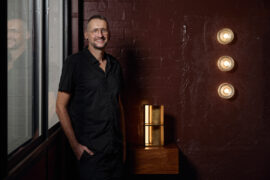As the Escher x nendo | Between two worlds exhibition continues to draw in crowds, we consider the timeless appeal of the Dutch master for architects and designers.

M. C. Escher: Convex and concave March 1955, lithograph. Escher Collection, Gemeentemuseum Den Haag, The Hague, the Netherlands © The M. C. Escher Company, the Netherlands. All rights reserved.
Paper architecture is a practice of drawing and designing, without the goal of ever building. On the page one can dream up a visionary or utopian idea for what a building, or even a city could look like.
It’s a big call but I’m going to go so far as saying that 20th-century Dutch artist M.C. Escher was the original paper architect.

M. C. Escher: Belvedere May 1958, lithograph. Escher Collection, Gemeentemuseum Den Haag, The Hague, the Netherlands © The M. C. Escher Company, the Netherlands. All rights reserved.
Most would recognise Escher’s work from his iconic optical illusions but there is much more to his body of work than staircases leading to nowhere. Escher was able to not only push the boundaries of what is possible in a drawing, but also what is possible in architecture. His work was well ahead of its time, featuring towers held up by impossibly spindly piloti, or axonometrics with multiple vanishing points.

M. C. Escher: Day and night February 1938, woodcut, printed in grey and black inks Escher Collection, Gemeentemuseum Den Haag, The Hague, the Netherlands © The M. C. Escher Company, the Netherlands. All rights reserved.
Commenting on the influence of Escher’s foresight on the architectural world, Tony Ellwood AM, director at the NGV says, “Escher’s artistic practice, due to its complex play with space, logic and mathematics, has had an indelible impact on architecture and design for many generations. This rich legacy was the catalyst for the NGV to conceptualise the idea of pairing Escher with nendo. We can’t wait for audiences to explore how art can be perceived and experienced differently through the lens of design.”

M. C. Escher: Ascending and descending March 1960, lithograph. Escher Collection, Gemeentemuseum Den Haag, The Hague, the Netherlands © The M. C. Escher Company, the Netherlands. All rights reserved.
From the exhibition design side of things, Japanese powerhouse studio nendo, fronted by Oki Sato, has taken reference and inspiration from the conceptual background of Escher’s work.
The result is a combination of thoughtful exhibition design and inspirational artistic work. And nendo’s execution of the final design is not without surprises.
Escher X nendo | Between Two Worlds is open at the National Gallery of Victoria until 7 April 2019.
INDESIGN is on instagram
Follow @indesignlive
A searchable and comprehensive guide for specifying leading products and their suppliers
Keep up to date with the latest and greatest from our industry BFF's!

Now cooking and entertaining from his minimalist home kitchen designed around Gaggenau’s refined performance, Chef Wu brings professional craft into a calm and well-composed setting.

For those who appreciate form as much as function, Gaggenau’s latest induction innovation delivers sculpted precision and effortless flexibility, disappearing seamlessly into the surface when not in use.

Merging two hotel identities in one landmark development, Hotel Indigo and Holiday Inn Little Collins capture the spirit of Melbourne through Buchan’s narrative-driven design – elevated by GROHE’s signature craftsmanship.

At the Munarra Centre for Regional Excellence on Yorta Yorta Country in Victoria, ARM Architecture and Milliken use PrintWorks™ technology to translate First Nations narratives into a layered, community-led floorscape.

Former INDE Luminary LeAmon joins the Design Institute of Australia (DIA) following more than a decade as the inaugural Curator of Contemporary Design and Architecture at the National Gallery of Victoria (NGV).

Stylecraft and NGV call for furniture and lighting designs addressing small-space living, with $20,000 prize and commercial development opportunity.

Celebrating ten years of creative impact, Melbourne Design Week 2026 invites designers, studios, and collectives to submit expressions of interest for its statewide program and the Melbourne Art Book Fair.

At the NGV’s Making Good: Redesigning the Everyday, design becomes a force for repair. From algae-based vinyl to mycelium earplugs, the exhibition proves that rethinking the ordinary can reshape our collective future.
The internet never sleeps! Here's the stuff you might have missed

Design Mumbai has concluded its second edition, reinforcing its position as India’s leading international showcase for contemporary design.

In the New Year, architecture will be defined by its ability to orchestrate relationships between inside and outside, public and private, humans and ecology, and data and intuition.